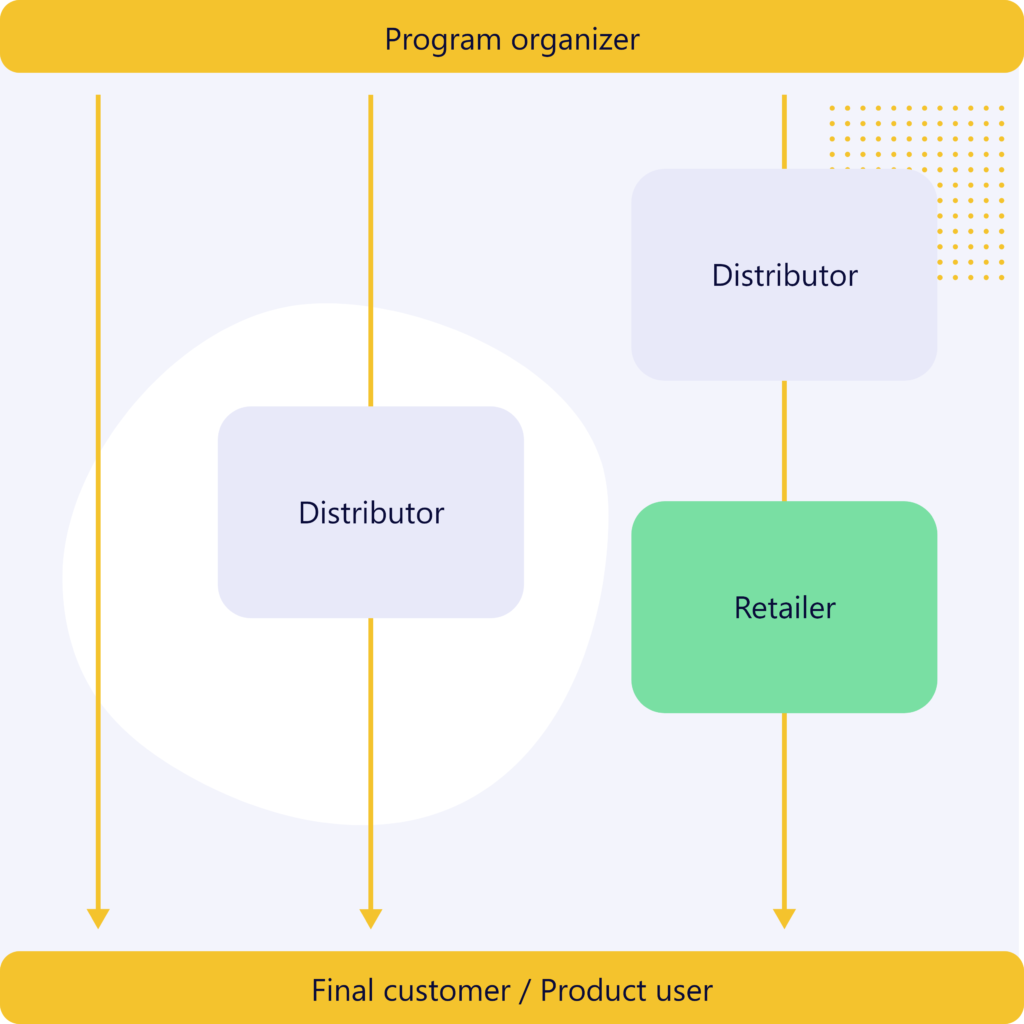The most common model for organizing a channel loyalty program is one in which the customers make purchases directly from the loyalty program organizer. But what if the product distribution model is more complicated, or the producer has no direct contact with end-users because they sell the product through a distribution network? In that case, would it be possible to organize a loyalty program for the end-users or final customers?
The essential elements of the distribution model
There are many ways to reach the customer. Your distribution model must be adjusted to the market, the specifics of the product itself and the customers’ needs and buying habits. The chosen type of distribution also depends on whether the producer operates in the B2B or B2C market. This article explains how to fit a channel loyalty program into a chosen distribution model, regardless of whether the product is bought directly from your company by the customer. To find the right fit, we need to consider the following three elements of distribution when planning a loyalty program:
- The manufacturer as the organizer of a channel loyalty program
- A distributor/wholesaler that is responsible for selling the product to the end-user or further distribution to retail stores
- The end-user
Assuming that the manufacturing company, despite the distribution network, is the one in charge of organizing the B2B loyalty program, we can distinguish three exemplary models of operations.
1. Direct-to-customer program model
When talking about the final customer, we consider not only the users of the product but also installers, contractors, designers and other specialists. This type of model will provide the best solution in the construction industry and other specialized fields — electrical installation, plumbing, or photovoltaic industries.
This model is based primarily on building relationships with the customers or the people who will decide on the use of the product. A perfect example is an electrician or an installer — although they are not the final user of the product, they are the one who chooses a particular product necessary to do the work, even though the final buyer or investor is often the customer. In this case, the incentive program operates by participants claiming their purchases (our sales or purchase claimer feature). Despite not selling the products directly, the producer receives feedback from the customer who has purchased through the distributor.

There are two ways to organize a business-to-business (B2B) loyalty program based on this model.
a) By uploading a copy of the accounting document or entering a code that the producer directly attached to the product
However, this method comes with several challenges:
- Verification of the accounting documents or managing the process of generating and attaching codes to your products
- Keeping your business safe from fraud, such as charging for returned goods
- Reaching out to the end-users of the product (with whom the organizer has no direct contact) and providing them with information about the program
At LoyaltyZen, we have created a model for both of these scenarios. The first feature is the sales claims module, and the other one is the product codes module. These features combined with the mobile member-engagement portal make this kind of B2B loyalty program or sales incentive program much easier to run, and what’s also important, easy to use and engaging for the members!
b) By involving distributors in a program aimed at end-users
For example, distributors could provide end-users with access to the sales incentive program (or a channel loyalty program)under certain rules. They would then be responsible for promoting the program to their customers and tracking points. However, the distributor would not have to be responsible for the costs of the B2B loyalty program. This also raises the challenge of having to share customer data with the program organizer. Not all distributors agree to this.
2. A program model aimed at distributors, stores or wholesalers
In this model, the distributor is treated as a member of the loyalty program — it is the beneficiary of the channel loyalty program. Sales are recorded on the basis of integration between LoyaltyZen and the organizer’s accounting system or by exporting XLS/CSV files from the accounting system or an ERP system. This model also allows the distributor’s salespeople to be rewarded, if needed. That allows you to further motivate your employees. The challenge associated with this model is to adapt the channel loyalty program to different scales of operation of each distributor with whom the manufacturer works. For example, one distributor can have sales that are 10 times higher than the average in your distribution network.
This issue can be solved with personalized sales targets or by using segmentation — adapting different rules based on the size of the member. This solution allows points to be transferred only when the distributor exceeds the threshold of the designated sales target.
3. Combined model
The mixed model combines the two above models, although it is aimed at the end-users, such as installers, contractors, specialists or others who buy the product from the distributor. The distributor is an active participant in the program and is responsible, for example, for marketing the program to the final users. Benefits are also offered to distributors, which may be based, among other things, on the points collected by customers.
The presented models should also be correlated with complementary benefits/perks, such as the possibility to participate in training or courses exclusive to the B2B channel loyalty program members. Another idea is to reward for additional, extra activities — e.g., displaying materials in the distributors’ stores. Of course, the rewards themselves are important for engaging program beneficiaries and should be tailored to their needs. These rewards may be specialist tools in the construction industry or packages or marketing services that support the distributors’ businesses.
Whatever model you choose, LoyaltyZen will guide you through the process to customize all elements of the program to meet the needs of your business and your customers.

